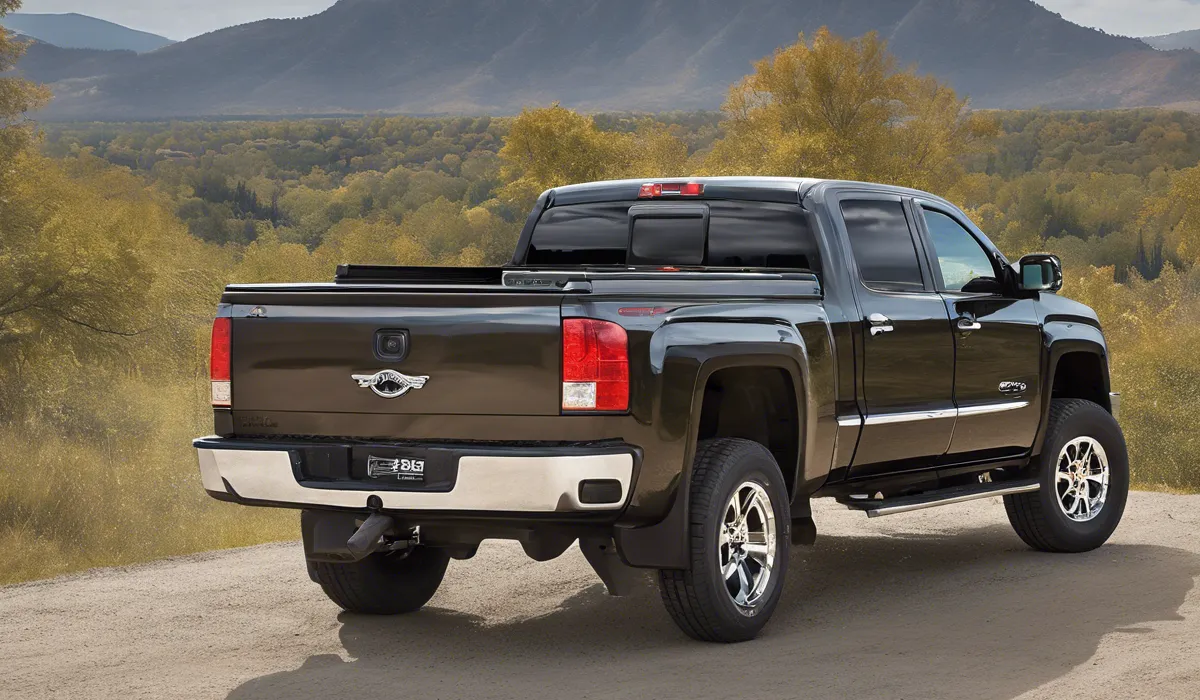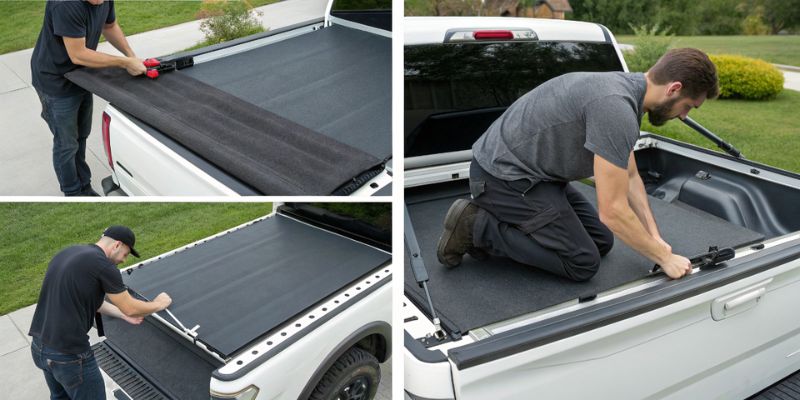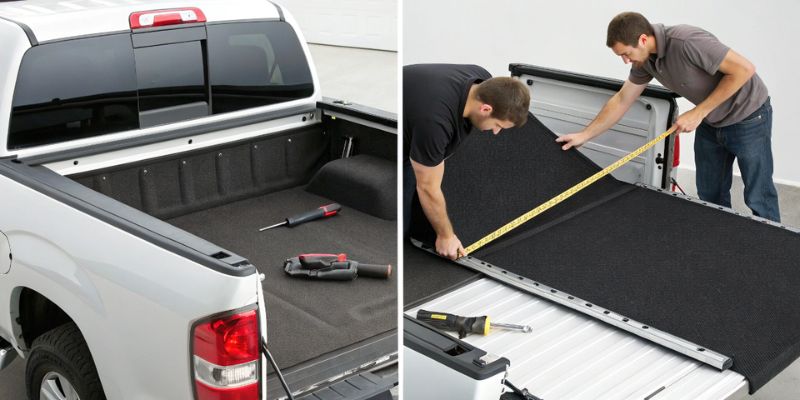Installing a tonneau cover can be relatively easy, often requiring no special tools or drilling. Most covers come with clear instructions and can be fitted within an hour. However, ease of installation varies by cover type and vehicle model. It’s generally a straightforward DIY task.
Understanding Tonneau Covers and Pre-Installation Requirements

Definition and Purpose of a Tonneau Cover
A tonneau cover is a crucial accessory for any pickup truck owner.
It serves as a protective shield over the truck bed, safeguarding cargo from the elements and potential theft.
Not only does it offer security, but it also enhances the vehicle’s aerodynamics, which can improve fuel efficiency.
Different Types of Tonneau Covers and Their Complexity Levels
Tonneau covers come in various styles, each varying in installation complexity.
Roll-up covers are known for their simplicity and ease of use.
Folding covers offer a robust design with the convenience of quick access.
Retractable covers provide a sleek look with user-friendly operation.
Lastly, hinged covers give a solid, one-piece protection but may require more effort in handling and installation.
Tools and Materials Needed for Installation
Most tonneau covers are designed for easy installation, often not requiring any special tools.
A typical toolset might include a wrench, a screwdriver, and possibly an Allen key.
Always confirm with the manufacturer’s manual to ensure that you have all necessary materials before starting the installation process.
Importance of Reading the Manufacturer’s Instructions
Before beginning the installation process, it is crucial to thoroughly read the manufacturer’s instructions.
These instructions provide specific details related to your tonneau cover model and can include crucial information about the installation process that ensures a secure fit and optimal performance.
Measuring Your Truck Bed for the Right Fit
Ensuring you have the correct size tonneau cover for your truck bed is essential.
Measure the bed’s length, width, and height to match with the appropriate cover size.
An incorrect size can lead to installation challenges and may compromise the cover’s effectiveness.
Step-by-Step Installation Process for Pre-Installation Requirements

Preparing the Truck Bed
Begin by cleaning the truck bed thoroughly.
Remove any debris or materials that might interfere with the installation.
Ensure the bed is dry to prevent rust or corrosion under the cover.
Laying Out All Components and Hardware
Unpack all components and lay them out.
Check the parts list in the manufacturer’s instructions to ensure you have all the necessary pieces.
Familiarize yourself with each part before starting.
Installing Roll-Up Covers
Roll-up covers usually require clamps to secure the side rails to the truck bed.
Ensure the rails are aligned with the bed’s edges and clamp them down evenly.
Unroll the cover and secure it at the end with the provided latch or fastening system.
Installing Folding Covers
Folding covers typically come pre-assembled.
Position the cover at the front of the bed and secure it with the designated clamps or bolts.
Fold the cover towards the tailgate, ensuring each section clicks into place or is secured as instructed.
Installing Retractable Covers
Retractable covers may require a bit more time due to their moving parts.
Install the canister at the front of the bed and attach the side rails.
Make sure the rails are level and the cover retracts smoothly before fully tightening all hardware.
Installing Hinged Covers
Hinged covers are often the heaviest and might require an extra set of hands.
Place the cover on top of the bed and align it with the truck’s profile.
Secure the hinges at the front, and ensure the cover opens and closes correctly without obstruction.
Tips for Ensuring Proper Alignment and Tension
Alignment and tension are vital for the functionality and longevity of the tonneau cover.
Make small adjustments to the positioning of the rails and clamps to ensure the cover is taut and evenly aligned with the truck bed.
Safety Precautions During Installation
Always prioritize safety during installation.
Wear protective gloves if handling sharp edges or heavy components.
If you need to drill or cut for certain cover types, take precautions to avoid injury or damage to your vehicle.
Troubleshooting and Maintenance Post Installation

Common Issues Encountered During and After Installation
After installation, you might encounter issues such as misalignment, improper sealing, or difficulty in operation.
These can often be resolved by revisiting the manufacturer’s instructions and making necessary adjustments.
Adjustments and Fixes for Common Problems
If the cover is not sealing correctly, check for gaps or uneven tension. Adjust the clamps or rails as needed.
For operational issues, ensure there is no obstruction in the cover’s path and that all components are tight and secure.
How to Maintain Your Tonneau Cover for Longevity
Regular maintenance includes cleaning the cover with appropriate products, checking for wear and tear, and ensuring all hardware remains tight.
Periodically lubricate any moving parts to keep the cover functioning smoothly.
When to Seek Professional Help for Installation or Repairs
If you encounter persistent issues or are not confident in your ability to install the cover correctly, seeking professional help is advisable.
A professional can ensure the installation is done right, potentially saving you time and preventing damage to your truck or the cover itself.
FAQs About Tonneau Cover Installation
Is a tonneau cover easy to install?
Yes, installing a tonneau cover is generally a straightforward DIY task that often requires no special tools or drilling, and can be completed within an hour.
Do I need any special tools to install a tonneau cover?
Most tonneau covers do not require special tools for installation and come with all necessary hardware for fitting.
Can I install a tonneau cover by myself?
Yes, many tonneau covers are designed for single-person installation, with clear instructions provided.
Will I need to drill holes in my truck to install a tonneau cover?
Most tonneau covers are designed for no-drill installation, but it can vary by cover type and vehicle model.
How long does it typically take to install a tonneau cover?
Installation time can vary, but most tonneau covers can be fitted within an hour following the provided instructions.
Final Thoughts
Installing a tonneau cover is typically a simple DIY project, often completed within an hour and without the need for special tools or drilling.
While the process is generally straightforward, the specific ease of installation can vary depending on the type of cover and the vehicle model.
Manufacturers usually provide clear instructions to facilitate the installation process.
